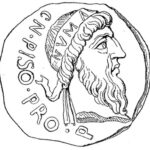As Michael Grant writes, ancient Roman sources are unclear and difficult to interpret unequivocally. Ancient rites were recorded in holiday calendars. What we have learned of this contains some material that goes back to the time of the Roman kings. Such religious events – the completion of annual religious rites – initially had the best chance of being remembered by the Romans.
Temple archivists and members of various priestly colleges passed down from generation to generation the year and day on which the temple was vowed to be built, and the day on which each of these temples was dedicated.
The oldest Roman (Latin) “prose” and, at the same time, the registration of the history of Rome, were thus represented by the official records of censors and Pontiffs, called commentarii – meaning “things worth remembering”, and lists of officials (libri lintei – “canvas books”).
Unfortunately, the remains of these records have reached us in a late form – the main reason for the destruction of most of the older records was the invasion of the Gauls in the 4th century BCE. So the oldest one left is the shattered calendar from Antium (first half of the 1st century BCE).
Already living in the times of Julius Caesar politician and writer Marcus Tullius Cicero provided important information on this subject:
For history was nothing else but a compilation of annals; and accordingly, for the sake of preserving the memory of public events, the pontifex maximus used to commit to writing the occurrences of every year, from the earliest period of Roman affairs to the time of the pontifex Publius Mucius, and had them engraved on white tablets, which he set forth as a register in his own house, so that all the people were able to inspect it; and these records are still called the Great Annals.
– Cicero, De Oratore , II.52
So the pontiffs probably owed these meticulous actions to their creator and first instructor, the king of Numa.
This writing is most suited to the already advanced urban culture and to the meticulous, even pedantic Etruscans, but it does not fit well with the archaic agrarian-pastoral in its structure and the slightly backward culture of the Sabines, from which Numa was supposed to have originated, according to later Roman historians.
Such a white information board was called an album (from the white colour). They were written with black or red ink, erased with white paint to make room for new entries. These oldest official records were called annales, “annals”. These were, in their essence, calendar sets with a list of days on which assemblies and judgments were allowed. They also included the names of consuls and other senior officials.
These “pontifical chronicles” (Tabulae pontificum), erased and re-written each year thereafter, contained a list of the annual feasts, intertwined (in blank spaces between holidays) with a record of what happened on the days when there were just ceremonies being performed, for example, notes were made of the treaties entered into, and also those reported cases where the gods were believed to have shown dissatisfaction with some religious offence (prodigia) and had to be appeased with an appropriate sacrifice (piaculum).
So they recorded such natural and political cataclysms as wars, natural disasters, solar or lunar eclipses. Probably some part of this wealth of information survived the sacking of Rome by the Gauls (390-387 BCE), but this is not certain.
A well-known politician and censor Appius Claudius Caecus caused the publication in 304 BCE. e. a calendar, the rules of which have thus been made public. The calendar released incl. he told everyone when and how (on “auspicious” days, fasti) it was possible and should have been brought before the court. Therefore, these matters ceased to constitute the “professional secret” of the pontiffs. It also led to the disappearance of white pontifical tablets over time.
Approx. 130 BCE these facts were not recorded on tables, they were entered into books in 128 BCE, some historian of the unknown name gave these materials the form of a uniform chronicle – the information gathered so far was published as Annales Maximi (or “Main Yearbooks”).
They were the source and the basis for later Roman historians who also initially called their history according to subsequent years Annales – recalls the later Greek historian Dionysius of Halicarnassus.








